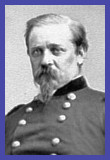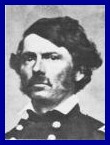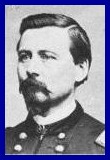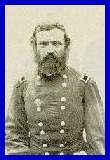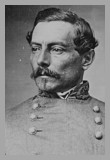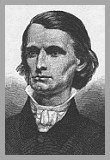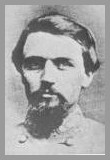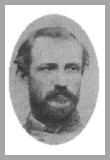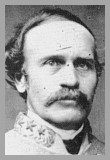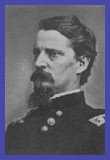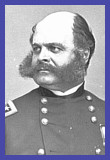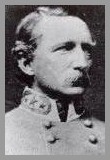| The move
against Petersburg was the ultimate objective of the
crossing of the James. While the Army of the Potomac,
with Hancock's II Corps in the lead, marched down to the
crossing point and over the river (some being ferried by
steamers), W. F. Smith's XVIII Corps took transports from
West Point on the York River all the way around the
Peninsula to Bermuda Hundred. From there, on June 15,
Smith was ordered to cross the Appomattox and march on
Petersburg. Smith was supposed to have his entire corps, but at the last minute one division (under Brig. Gen. Adelbert Ames) was withheld by Army of the James commander Maj. Gen. Ben Butler, and replaced by the X Corps division of Brig. Gen. Edward Hincks, consisting entirely of untried U.S.C.T. regiments. In addition, Smith had Brig. Gen. August Kautz's division of cavalry, making a total force of at least 10,000, possibly as high as 14,000. The Federals were across the Appomattox River and on the City Point Road by 5:00 a.m., only about eight miles from Petersburg, and made contact with Confederate skirmishers at around 6:00 a.m., but it was not until 11:00 in the morning that Hincks's division pulled up in front of the Petersburg lines, and possibly as late as 2:00 before the last division (Brig. Gen. John Martindale, on the right) arrived. Gen. W.H.T. Brooks's division held the center. Most of this delay was due to a spirited defense by some cavalry under Brig. Gen. James Dearing (who had commanded Pickett's artillery at Gettysburg). His Rebel force of about 850 held up Smith for two hours at the Baylor farm, some three and a half miles from the main Petersburg lines. Some of the delay, however, has to be attributed to Smith's own caution. The fortifications around Petersburg stretched from the Appomattox River east of town, all the way around to the same river west of town and consisted of 55 numbered batteries or redoubts, connected by strong lines of entrenchments. The line was known as the Dimmock Line, in honor of the Confederate engineering officer who supervised its construction in 1862 and 1863. (Click here for a map of the immediate Petersburg area.) Overall command of Confederate forces at Petersburg and Bermuda Hundred was in the hands of Gen. P.G.T. Beauregard. At the time that Smith and XVIII Corps arrived in his front, Beauregard had half of Dearing's cavalry brigade and a single infantry brigade under the former Virginia governor, now brigadier general, Henry Wise. Reinforcements from the Bermuda Hundred lines had been ordered to march rapidly for Petersburg, but could not reach the city before late evening. Until then, Wise's 2200 men (plus Dearing's two regiments of cavalry) were all that Beauregard had to work with. Having participated in the debacle at Cold Harbor, Smith was reluctant to assault what was obviously a very strong position. After a lengthy personal recon, however, he was able to determine to his satisfaction that the lines were thinnly manned, although bolstered by a lot of artillery. Smith therefore decided to attack in open formation, i.e., essentially as a huge skirmish line, in order to minimize the effect of the Rebel artillery. It took Smith --- who admittedly was suffering from the effects of a malaria attack and some bad water he had drunk at Cold Harbor --- until nearly 5:00 p.m. to decide where and how to attack, and then it was learned that the corps artillery commander had sent all the horses off to be watered! The attack finally stepped off at 7 p.m. --- seven and half hours after the Federals first reached the enemy lines --- and was largely successful, which is no surprise since the lines were so sparsely manned. The Federals seized a stretch of line over a mile wide, containing nine redoubts, and backed up by absolutely nothing. The attack was aimed at a salient in the Dimmock Line which projected out between Battery 2 (just north of the City Point Railroad) and Battery 8, halfway between the railroad and the road to Prince George's Courthouse. Batteries 3 through 11 fell to the Federal attackers, along with at least 250 Rebel prisoners, mostly from the 26th and 46th Virginia regiments. Five of the captured battery positions fell to the USCT regiments in Hincks's division; the rest fell to W.H.T. Brooks's troops. Despite the ease of his success and the opportunity to expand his gains before enemy reinforcements could arrive, Smith decided not to press the attack that night. "Deeming that I held the important points of the enemy's line of works, I thought it prudent to make no farther advance." Smith's failure to press his advantage at Petersburg has been the subject of much argument and contention. In his post-war writings, Smith was adamant that the failure was not due to any error or caution on his part, but instead tried to throw all the blame on Grant and Butler. For an extended discussion of this issue, click here. There was still a chance for decisive success on this day. The Federals had intended that Hancock's II Corps would be available to support and perhaps even join in the attack on Petersburg, but for some reason no one had told Hancock, who crossed the James and paused to feed his troops, in the course of which there were substantial delays, and then the corps got lost trying to find a non-existent spot on a map. Finally told that he was expected to be supporting Smith, Hancock put his men on the road. They began arriving about the same time as Smith's attack went forward. It was bright, moonlit night, and, while Hancock's men were tired from the all-day march, they understood that a march had been stolen on Lee and now was the time to take advantage of it. Hancock was the senior officer of the two (although Smith had been his division commander in 1862, when Hancock led a VI Corps brigade), but he deferred to Smith because the XVIII Corps commander had been on the ground all day and therefore was more familiar with the tactical situation. Instead of pressing forward with a night advance, Smith asked Hancock to relieve his own troops. Post-war accounts by Federal troops indicate that the men in the ranks understood that an opportunity was being thrown away here, but the die had been cast. If the Federals were to take Petersburg, it would not be on June 15th. Beauregard, who had arrived during the day to supervise the defense, was astonished that he was not attacked again that night. Writing after the war, he said that "Petersburg at that hour was clearly at the mercy of the Federal commander, who had all but captured it." During the night the Confederates pulled back to a new line and dug in as best they could, all the while screaming for help from Lee. The only reinforcements Beauregard could scrape together was the division of Robert Hoke, taken from the Bermuda Hundred lines, which arrived just after Smith's attack ground to a halt. Lee refused to send help, being convinced that Grant was about to attack east of Richmond. Desperate for help, Beauregard completely abandoned the Bermuda Hundred line, pulling out Bushrod Johnson's division to reinforce Petersburg. Vacating the Bermuda Hundred line was a gamble fraught with great risk. If the Federal troops on the Bermuda Hundred peninsula -- Ben Butler's Army of the James -- were to advance from their own lines they might well be able to interpose between Lee's position north of James River, and Petersburg to the south of the Appomattox, force Lee to fight a major battle simply to get reinforcements to Beauregard. As it happened, the Federal troops did move forward, but cautiously and not in great strength, and so Lee was able to push them aside without too much effort or delay. Still, it was another missed opportunity for the Yankees. (For a more extensive discussion of this issue, click here.) As dawn of June 16th broke at Petersburg, Beauregard had a force of about 14,000 men, deployed with Hoke's division on the left, next to the river and extending to about halfway between the Prince George's Court House Road and the Baxter Road, and Johnson's division on the right, the latter arriving just in time to help beat off a Federal attack on the Confederate far right. This much force was probably strong enough to hold off Smith and Hancock; however, late on the morning of the 16th U.S. Grant arrived with Burnside and IX Corps, giving the Federals about 50,000 men, arranged with XVIII Corps on the right, along the river, II Corps in the center between the Prince George's Court House and Baxter Roads, and IX Corps going into line on the left, roughly astride the Baxter Road. A morning probe was made along Hancock's front --- it was this attack, in part at least, that Johnson's timely arrival helped to defeat --- in order to develop the Confederate lines for a later attack, which Grant ordered Hancock to make at 6 p.m. Meanwhile Meade arrived at Petersburg and Grant returned to City Point to coordinate efforts with Butler's Army of the James. Hancock's attack pressed the Union lines up close to Beauregard's center, but failed to breach the Rebel defenses. The advance resulted in the seizure of three more of the Dimmock Line redoubts, but these had been essentially rendered untenable by Beauregard's withdrawal after Smith's attack the night before. IX Corps developed the Rebel lines on the Federal left in addition to supporting II Corps, but made no major effort on its own to attack the enemy; XVIII Corps supported on the right, but likewise did very little to actually exert pressure on the Confederate position. Federal efforts on this day seemed even more disjointed and poorly planned than those of the 15th. The evening attack was a half-hearted effort along only a portion of the Rebel front. No one on the Federal side seems to have thought of sending a force south and west of Petersburg, then north, to strike the Dimmock Line where it was basically empty of troops. (In fairness to the Federal high command the road network at Petersburg did not lend itself well to this kind of manuever.) Efforts to advance along the river were hampered by enfilade fire from Rebel batteries north of the Appomattox. During the night of June 16-17, Meade received information indicating that Lee's troops were still north of the James, confirming information delivered by escaped prisoners who had worked their way through the lines. Thus satisfied that the trenches in his front were not manned by the Army of Northern Virginia, Meade ordered a moonlight assault, to be carried out by Burnside's IX Corps. Owing to the time required for preparation, the attack was put off until dawn. The objective of the attack was a salient occupied by the Shand House, just north of the Baxter Road, and defended by Bushrod Johnson's Tennessee brigade. A breakthrough here would rupture the connection between the new Confederate line and the Dimmock Line, and possibly give the Federals access to the Baxter Road as an avenue of attack directly into town. The attack would be led by Brig. Gen. Robert Potter's Second Division, with the other two IX Corps divisions (Ledlie and Willcox) supporting on the flanks. (The remaining IX Corps division, 4/IX under Ferraro, was still guarding the James River bridges.) During the night Potter had his men quietly take up position, massed for the attack, just behind their own picket line below the hill on which the Shand House stood. Stepping off to the attack at 3 a.m., Potter's men achieved one of the great tactical successes of the war, taking another mile of the main line and nearly 600 prisoners before running out of steam. Incredibly, Potter's men were unsupported on either flank, an error that he felt prevented the collapse of the entire Rebel line, "from the Appomattox to the Jerusalem Plank Road," as he later put it. Other Federal attacks were uncoordinated and Beauregard was able to defeat them, one at a time, as they occurred. But he knew he was in trouble. Warren's V Corps had arrived that morning and was extending the Federal left next to Burnside. Willcox finally attacked on the left of Potter's division, but not until 2 p.m., and then the effort was so mis-managed as to succeed only in mangling one of the Federal brigades. At 6 p.m., Ledlie attacked the new Rebel line formed behind the Shand House Hill, and although initially successful in achieving a lodgement, the attack was unsupported and a Rebel counterattack that night drove Ledlie back with heavy losses. Foreshadowing tragic events a month and a half later, Ledlie remained in the rear when his division went forward, lying on the ground in a drunken stupor, according to the post-war comments of one of his regimental commanders. Almost all of the fighting this day had been done by IX Corps, just as almost all of the fighting the day before had been by II Corps. On the Federal right, Smith's XVIII Corps did not accomplish much except to skirmish with the enemy. Hancock, on Smith's left, did very little on his front, although the continued problems he was having with his Gettysburg wound may have contributed to this. While a vigorous effort by Hancock (especially Barlow, who was on Potter's right and might have been able to exploit that success) could well have been decisive, it cannot be ignored that the II Corps troops-- officers as well as men -- were physically exhausted from the marching and fighting of the previous four days. So far, all of the Federal attacks had all come against the eastern face of the oval-shaped Dimmock Line, together with a very short stretch along the south face, and had in fact pushed it back quite a ways. The Federals now held a front from the Appomattox River all the way to the Norfolk and Petersburg Railroad, and in fact a touch beyond the tracks. (The entire stretch of the Dimmock Line from Battery 3, near the river, to Battery 17, was now in Federal hands.) Beauregard's right was in serious danger because of the Federal successes there and the advance -- however halting -- of Warren's V Corps, so he decided to take up a new line in the rear of his present position. At 12:30 or so on the morning of June 18th, the Confederates pulled back and commenced to construct a new line, running generally from Redoubts 25-29 (soon to be the site of Fort Mahone) north to the river. This new line was about a mile in the rear of the original Dimmock Line, and about half a mile or so from the city proper. It was a strong line, running along the course of a small stream known as Taylor's Branch. Beauregard still had received no troops from Lee. However, by 3 a.m. on the 18th, Lee's son Rooney had finally been able to press forward far enough to actually see the Federal pontoon bridge over James River, and this, together with prisoner reports sent by Beauregard, convinced the commander of the Army of Northern Virginia that the Federal Army was indeed entirely south of the river, and so the grayclad veterans set off to relieve beleaguered Beauregard. The divisions of Field and Kershaw led the way. The previous evening Meade had ordered a strong attack to be made along the entire Federal line, at 4 o'clock in the morning. This attack struck thin air, of course, as the Confederates had drawn back, and it was nearly 2 p.m. when Beauregard's new line was finally developed. Hancock was lost during the night when his Gettysburg wound re-opened and began to hemorrhage. Command of II Corps now fell to Maj. Gen. David B. Birney, a solid commander but not as aggressive as Hancock, and not used to commanding the corps. In the meantime June 18th became the most frustrating day in George Meade's year-long tenure as commander of the Army of the Potomac. Meade knew that Lee's troops were not yet at hand, but might be at any moment now, and he became increasingly exasperated at the inability of his commanders to close up on each other and the new enemy position. The ultimate frustration was yet to come. At 7:30 a.m.or so, Kershaw's troops crossed the Appomattox River, the first of Lee's veterans to arrive, followed two hours later by Field's division. Lee's men were stationed on the Confederate right, thought to be the weakest point of the new line. Finally, at about noon, a series of half-hearted attacks were made along the II Corps front and to its right, by Martindale's division of XVIII Corps. Losses were heavy and gains were slight. The news of this "assault," when it reached Meade's headquarters, only increased the level of frustration and the edginess of Meade's temper. Soon after 2 p.m., Meade essentially lost control. In response to a dispatch from Warren explaining why it was not his (i.e., Warren's) fault that V Corps was unable to advance, Meade reminded the V Corps commander that his orders to attack were repeated and explicit, and any further delay would result in "consequences." Half an hour later a similar order went to Birney, now in command of II Corps, as well as Burnside. The attacks that were made throughout the rest of the day were unsuccessful and bloodily so. There was even less coordination than on the 17th, and the Federals were approaching exhaustion after four days of marching and fighting. Warren's attack, finally made at about 3 p.m., succeeded only in heavy losses and the near-fatal wounding of Col. Joshua Lawrence Chamberlain, shot through both hips while (supposedly) leading his brigade in an assault on the position known as Rives Salient.** At 4 p.m., came a final effort by Birney, in which the 1st Maine Heavy Artillery lost 632 men out of about 850 engaged. (It was in this attack that Army of the Potomac veterans refused to go forward, having tried three times already that day and being convinced that the enemy position was too strong; however, this was the only instance in this four day period in which the troops refused to go forward.) Finally, at about 5:30 p.m., Willcox's division and part of Potter's made a final attack in the IX Corps sector, and secured a position significantly closer to the main Rebel line than was the case elsewhere on the Federal lines. (Within a few weeks, Henry Pleasants and the 48th Pennsylvania would begin digging the mine in this sector.) Meade called off all further attacks at 6:30, then had to argue down Warren, who wanted to make another effort at 7 p.m. Federal casualties for the four day effort are generally pegged at around 11,000. Confederate casualties are not known. No doubt they were much less. The 18th was no doubt the day of the greatest Federal loss and least Federal success. The 15th and 17th were the days that should have seen the greatest Federal success: The 15th because of the unpreparedness of the Rebel defenders and their lack of numbers, the 17th because this was the last day before Lee's troops arrived and there had been time to plan a coordinated attack for the entire Federal force. Beauregard deserves a full measure of credit for his skillful defense prior to Lee's arrival. On the Federal side, Smith's caution --- to the end of his days, Smith tried to deflect criticism for having failed to take the city on the 15th --- the poor staff-work that made Hancock late on the 15th, and a general tactical breakdown of command on the 17th and 18th contributed to the failure to take the city, as did simple physical exhaustion of the Federal troops, who had made long and tiring marches in the June heat to get to Petersburg prior to being thrown into combat. The Federal officers on the scene seemed to have no sense of urgency about pressing forward their vanishing numerical advantage; this is seen, for example, in the failure of anyone to develop the new enemy line during the early morning of the 16th. Grant deserves some censure for managing the operation from his headquarters at City Point, about eight miles away, rather than exercising more direct control. While it needs to be remembered that Meade still commanded the Army of the Potomac and that the extent to which Grant took over tactical control during the campaign is vastly overstated, this was the most crucial operation of the campaign and it could have used a little more of the kind of energy and urgency that Grant's presence would no doubt have brought. |
|
|||||||||||||||
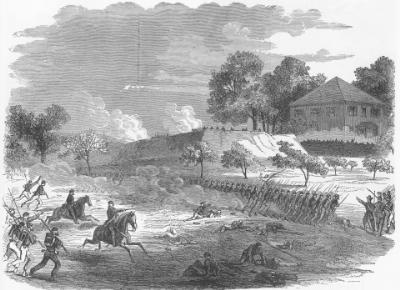 |
Return to Siege main page. Return to list of accounts. Go to previous page. Go to next page.
|


